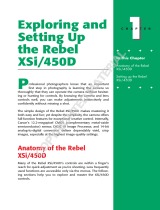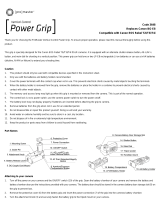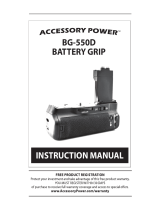Page is loading ...

EF-S18-55mm f/3.5-5.6 IS STM
Instructions
ENG

ENG-1
Thank you for purchasing a Canon product.
The Canon EF-S18-55mm f/3.5-5.6 IS STM
lens is a high-performance standard zoom
lens equipped with an Image Stabilizer,
and has been developed for EOS cameras
compatible with EF-S lenses*.
"IS" stands for Image Stabilizer.
"STM" stands for stepping motor.
Features
1. Improved Movie Shooting Functions
• Stepping motor with lead screws achieves quiet,
smooth Movie Servo AF.
*
2
2. High-speed, quiet Autofocusing achieved during
viewnder shooting.
* Only the following EOS cameras are compatible
with EF-S lenses (as of May 2014):
EOS 7D, EOS 70D, EOS 60D, EOS 60Da, EOS
50D, EOS 40D, EOS 30D, EOS 20D, EOS 20Da,
EOS REBEL T5i/700D, EOS REBEL SL1/100D,
EOS REBEL T4i/650D, EOS REBEL T3i/600D, EOS
REBEL T2i/550D, EOS REBEL T1i/500D, EOS REBEL
XSi/450D, EOS REBEL T5/1200D, EOS REBEL
T3/1100D, EOS REBEL XS/1000D, EOS DIGITAL
REBEL XTi/400D DIGITAL, EOS DIGITAL REBEL
XT/350D DIGITAL, EOS DIGITAL REBEL/300D DIGITAL
EOS M2*
1
and EOS M when used together with
Mount Adapter EF-EOS M
3. Aspherical lens element result in outstanding
image delineation.
4.
Equipped with an Image Stabilizer that provides
an image stabilization eect equivalent to a shutter
speed 3.5 stops*
3
faster (when the focal length is
set to 55 mm, equivalent to 88 mm in the 35mm
lm format, and when used with the EOS 7D).
The Image Stabilizer also provides optimal image
stabilization that responds to shooting conditions
(such as shooting still subjects and following shots).
5.
Electronic manual focusing (MF) made possible by
electronically detecting the rotation of the focusing ring.
6.
Manual focusing is available after the subject comes
into focus in autofocus mode (ONE SHOT AF).
*1: Not available in certain countries and regions.
*2: Function compatible with the following camera (as
of May 2014):
EOS 70D, EOS REBEL T5i/700D, EOS REBEL
SL1/100D, EOS REBEL T4i/650D
EOS M2*
1
and EOS M when used together with
Mount Adapter EF-EOS M
*3:
Image stabilization performance based on CIPA
(Camera & Imaging Products Association) Standards.
During actual shooting, image stabilization
performance varies depending on the amount of
camera shake, shooting conditions, and other factors.

ENG-2
Safety Precautions
Do not look at the sun or a bright light source
through the lens or camera. Doing so could result in
loss of vision. Looking at the sun directly through the
lens is especially hazardous.
Whether it is attached to the camera or not, do not
leave the lens under the sun without the lens cap
attached. This is to prevent the lens from concentrating
the sun’s rays, which could cause a re.
Conventions used in this instruction
Warning to prevent lens or camera malfunction
or damage.
Supplementary notes on using the lens and
taking pictures.
Handling Cautions
If the lens is taken from a cold environment into a
warm one, condensation may develop on the lens
surface and internal parts. To prevent condensation
in this case, rst put the lens into an airtight plastic bag
before taking it from a cold to warm environment. Then
take out the lens after it has warmed gradually. Do the
same when taking the lens from a warm environment
into a cold one.
Do not leave the lens in excessive heat such as in a car
in direct sunlight. High temperatures can cause the
lens to malfunction.
Usage Precautions
When using this lens with an EOS REBEL T4i/650D
camera, please be sure to update the camera’s
rmware to version 1.0.4 or later.
If the EOS REBEL T4i/650D rmware is an earlier
version than 1.0.4, there is a slight chance that the
camera will stop operating. If this occurs, please remove
the battery temporarily and insert it again for correct
camera operation.
For information on rmware updates, please check the
Canon website.

ENG-3
Safety Precautions
This device complies with Part
15 of the FCC Rules.
Operation is subject to the following two conditions: (1) This
device may not cause harmful interference, and (2) this
device must accept any interference received, including
interference that may cause undesired operation.
Do not make any changes or modications to the equipment
unless otherwise specied in the instructions. If such
changes or modications should be made, you could be
required to stop operation of the equipment.
This equipment has been tested and found to comply with
the limits for a class B digital device, pursuant to part 15
of the FCC Rules. These limits are designed to provide
reasonable protection against harmful interference in a
residential installation. This equipment generates, uses and
can radiate radio frequency energy and, if not installed and
used in accordance with the instructions, may cause harmful
interference to radio communications.
However, there is no guarantee that interference will not
occur in a particular installation. If this equipment does
cause harmful interference to radio or television reception,
which can be determined by turning the equipment o and
on, the user is encouraged to try to correct the interference
by one or more of the following measures:
• Reorient or relocate the receiving antenna.
• Increase the separation between the equipment and
receiver.
• Connect the equipment into an outlet on a circuit dierent
from that to which the receiver is connected.
• Consult the dealer or an experienced radio/TV technician
for help.
CAN ICES-3 (B) / NMB-3 (B)

ENG-4
Shooting Precautions
The EF-S18-55mm f/3.5-5.6 IS STM utilizes a stepping motor that drives the focus lens. The motor
also controls the focus lens during zooming.
1. When the camera is OFF
The motor does not operate while the camera is OFF or when the camera is OFF due to the use of the auto power
o function. Therefore, users must be aware of the following points.
Manual focus adjustments are not possible.
During zooming, delayed focus will occur.
2. When the lens is in sleep mode
If not operated for a certain period of time, this lens will enter sleep mode in order to save power. Sleep mode
diers from when the camera is OFF due to the use of the auto power o function. In this state, the motor will not
operate even if the camera is ON. Therefore, users must be aware of the following points.
Manual focus adjustments are not possible.
During zooming, delayed focus will occur.
To exit sleep mode, press the shutter button halfway.
3. During initial reset
When the camera is ON or when the camera is turned ON by pressing the shutter button halfway down when the
camera is OFF due to the use of the auto power o function*1, the lens performs an initial reset of the focus lens.
Although the image in the viewnder will appear out of focus during the initial reset, this does not mean that the
lens has malfunctioned.
Although the shutter can be released during the initial reset, users must wait approximately 1 second*2 after the
initial reset has completed before shooting.
*1: Applicable to the following EF-S lens compatible EOS cameras:
EOS 7D, EOS 70D, EOS 60D, EOS 60Da, EOS 50D, EOS 40D, EOS 30D, EOS 20D, EOS 20Da, EOS REBEL
T3i/600D, EOS REBEL T2i/550D, EOS REBEL T1i/500D, EOS REBEL XSi/450D, EOS REBEL T5/1200D, EOS
REBEL T3/1100D, EOS REBEL XS/1000D, EOS DIGITAL REBEL XTi/400D DIGITAL, EOS DIGITAL REBEL
XT/350D DIGITAL, EOS DIGITAL REBEL/300D DIGITAL
*2: The initial reset time varies depending on camera being used.

ENG-5
Focus mode switch (→ 6)
Hood mount (→ 7)
Lens mount index (→ 6)
Image stabilizer switch (→ 8)
Contacts (→ 6)
Zoom ring (→ 7)
Filter Mounting Thread
(→ 10)
Focusing ring (→ 6)
Zoom position index (→ 7)
For detailed information, reference page numbers are provided in parentheses (→ **).
Nomenclature

ENG-6
See your camera’s instructions for details on
mounting and detaching the lens.
After detaching the lens, place the lens with
the rear end up to prevent the lens surface and
contacts from getting scratched.
If the contacts get soiled, scratched, or have
ngerprints on them, corrosion or faulty
connections can result. The camera and lens
may not operate properly.
If the contacts get soiled or have ngerprints on
them, clean them with a soft cloth.
If you remove the lens, cover it with the dust
cap. To attach it properly, align the lens mount
index and the index of the dust cap as shown
in the diagram, and turn clockwise. To remove it,
reverse the order.
Mounting and
Detaching the Lens
1
Setting the Focus
Mode
2
After autofocusing in ONE SHOT AF mode, focus
manually by pressing the shutter button halfway
and turning the focusing ring. (Full-time manual
focus)
To shoot in autofocus (AF) mode, set the focus
mode switch to AF.
To use only manual focusing (MF), set the focus
mode switch to MF, and focus by turning the
focusing ring.
Quickly rotating the focusing ring may result in
delayed focus.
Manual focus adjustments are not possible when
the camera is OFF.

ENG-7
Hood (sold separately)
4
Zooming
3
To zoom, turn the lens’ zoom ring.
Be sure to nish zooming before focusing.
Zooming after focusing can aect the focus.
Blurring may temporarily occur if the zoom ring is
quickly rotated.
Zooming when the camera is OFF will result in
delayed focus.
Zooming during still image exposure will result in
delayed focus. This causes any streaks of light
that are captured during exposure to be blurred.
The EW-63C hood cuts out unwanted light and
protects the front of the lens from rain, snow,
and dust.
To attach the hood, align the hood’s attachment
position mark with the red dot on the front of the
lens, then turn the hood as shown by the arrow
until the lens’ red dot is aligned with the hood’s
stop position mark.
The hood can be reverse-mounted on the lens
for storage.
If the hood is not attached properly, vignetting
(darkening of the perimeter of the picture) may
occur.
When attaching or detaching the hood, grasp the
base of the hood to turn it. To prevent deformation,
do not grasp the rim of the hood to turn it.

ENG-8
You can use the image stabilizer in AF or MF
mode.
This function provides optimal image stabilization
depending on shooting conditions (such as
shooting still subjects and following shots).
1 Set the STABILIZER switch to ON.
If you are not going to use the image stabilizer
function, set the switch to OFF.
2
When you press the shutter button halfway,
the Image Stabilizer will start operating.
Make sure the image in the viewnder is stable,
then press the shutter button the rest of the way
down to take the picture.
Image Stabilizer
5
When shooting a still subject, it compensates for
camera shake in all directions.
It compensates for vertical camera shake during
following shots in a horizontal direction, and
compensates for horizontal camera shake during
following shots in a vertical direction.
When you use a tripod, the Image Stabilizer
should be turned o to save battery power.
Even with a monopod, the Image Stabilizer will
be as eective as during hand-held shooting.
However, depending on the shooting environment,
the Image Stabilizer eect may be less eective.
The image stabilizer function also operates when the
lens is used with an Extension Tube EF12 II or EF25 II.
If you set the camera’s Custom Function to
change the assigned button to operate the AF,
the Image Stabilizer will operate when you press
the newly assigned AF button.
The Image Stabilizer cannot compensate for a
blurred shot caused by a subject that moved.
The Image Stabilizer may not be fully eective
if you shoot from a violently shaking vehicle or
other transportation.
The Image Stabilizer consumes more power
than normal shooting, resulting in fewer shots
and a shorter movie shooting time.

ENG-9
Image Stabilizer
In semi-darkened areas such as indoors or
outdoors at night.
In locations where ash photography is
prohibited, such as art museums and theater
stages.
In situations where your footing is uncertain.
In situations where fast shutter settings
cannot be used.
When panning subjects in motion.
OFF
ON
OFF
ON
The image stabilizer for this lens is eective for hand-held shots in the following conditions.

ENG-10
You can attach extension tube EF12 II or EF25
II for magnied shots. The shooting distance
and magnication are shown below.
MF mode is recommended for accurate focusing.
You can attach lters to the lter mounting
thread on the front of the lens.
Only one lter may be attached.
If you need a polarizing lter, use the Canon
Circular Polarizing Filter PL-C B (58 mm).
To adjust the polarizing lter, rst remove the
lens hood.
Filters
(sold separately)
6
Extension Tubes
(Sold Separately)
7
Focusing Distance Range (mm)
Magnication (×)
Close distance Long distance Close distance Long distance
EF12 II
18mm Incompatible
55mm 209 382 0.65 0.23
EF25 II
18mm Incompatible
55mm 201 270 1.00 0.51

ENG-11
Attaching a 250D or 500D (58mm) Close-up
Lens enables close-up photography.
The magnication will be as follows.
Close-up Lenses
(Sold separately)
8
Close-up Lens 250D: 0.08x - 0.52x
Close-up Lens 500D: 0.04x - 0.44x
MF mode is recommended for accurate focusing.

ENG-12
* Applies to 1/3-stop increments. With 1/2-stop increments, it will be f/22-38.
Equivalent to 29-88 mm in the 35mm lm format.
The lens length is measured from the mount surface to the front end of the lens. Add 24.2 mm
when including the lens cap and dust cap.
The size and weight listed are for the lens only, except as indicated.
Extenders cannot be used with this lens.
Aperture settings are specied on the camera. The camera automatically compensates for
variations in the aperture setting when the camera is zoomed in or out.
All data listed is measured according to Canon standards.
Product specications and appearance are subject to change without notice.
Specications
9
Focal Length/Aperture 18-55mm f/3.5-5.6
Lens Construction 11 groups, 13 elements
Minimum Aperture f/22-36*
Angle of View Diagonal: 74°20′ - 27°50′, Vertical: 45°30′ - 15°40′, Horizontal: 64°30′ - 23°20′
Min. Focusing Distance 0.25 m/0.82 ft.
Max. Magnification 0.36x (at 55mm)
Field of View Approx. 129 x 199 - 42 x 63 mm/5.08 x 7.83 - 1.65 x 2.48 inch (at 0.25 m/0.82 ft.)
Filter Diameter 58 mm
Max. Diameter and Length 69.0 x 75.2 mm/2.72 x 2.96 inch
Weight Approx. 205 g/7.2 oz
Hood EW-63C (Sold Separately)
Lens Cap E-58 II
Case LP1016 (Sold Separately)

CT1-8588-004 0920Ni © CANON INC. 2012
/




